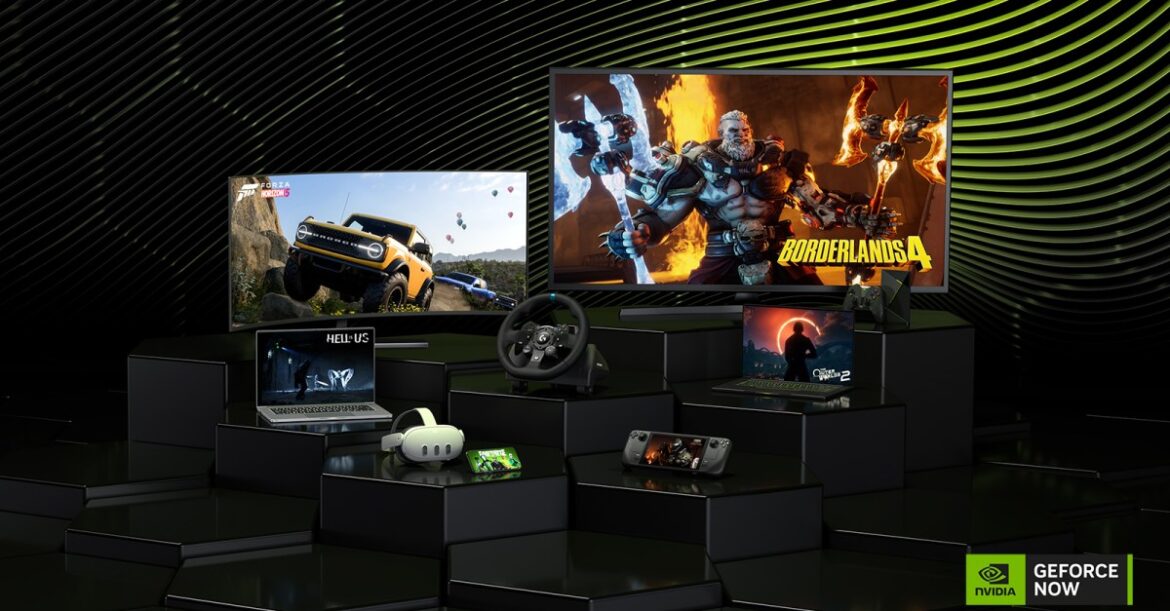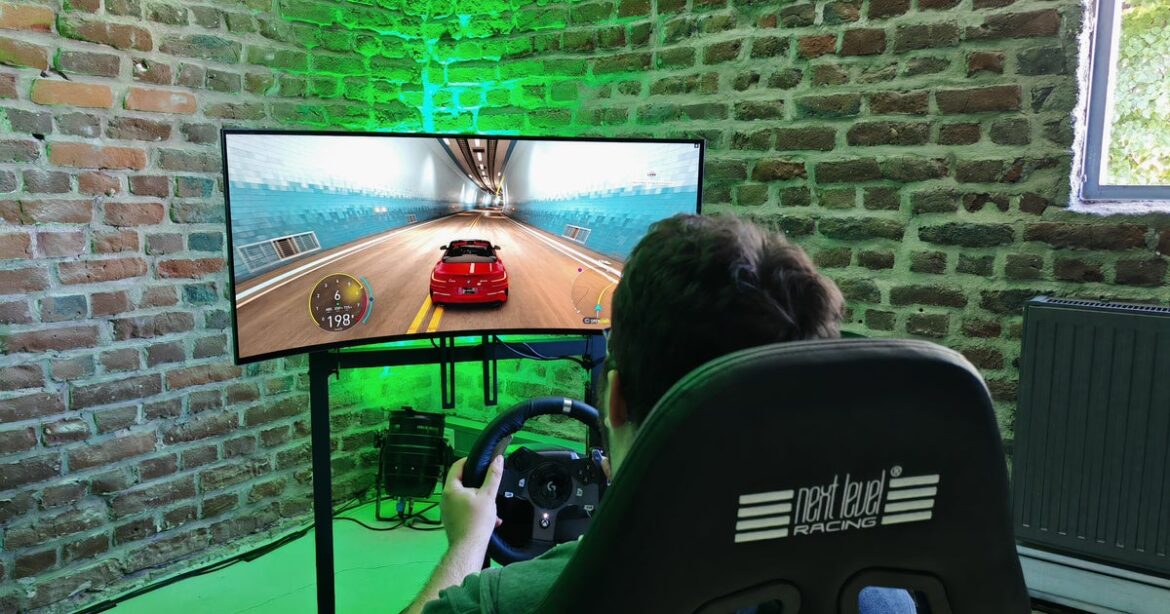Today, Nvidia is soft-launching its latest gaming GPUs in the cloud — upgrading its $20-a-month GeForce Now Ultimate cloud gaming service with RTX 5080 graphics for select games, with more to come down the road. At the same time, it’s also adding thousands more titles to the bring-your-own-games service by letting you install them yourself, while also unlocking a 360Hz mode for ultra-fast desktop monitors, launching a 90Hz version of its Steam Deck app, and more.
Do all these changes make GeForce Now fundamentally better? Absolutely, and it was already pretty good! But while playing I couldn’t escape the thought: it’s a good thing Nvidia isn’t charging extra for most updates, because they’re a little underwhelming right now.
Cyberpunk 2077 is playable with all the Nvidia eye candy — if you use all the Nvidia tricks.
For the uninitiated, Nvidia’s GeForce Now is a game streaming service that farms the graphical processing power out to the cloud. Instead of controlling a game running locally on your Steam Deck or MacBook or phone, you’re effectively remote-controlling an RTX 5080 or 4080-powered* gaming rig in a server farm many miles away, which you sync with your existing Steam, Epic, Ubisoft, Xbox, and Battle.net accounts to access your games and savegames from the cloud.
*Nvidia’s GeForce Now also technically has a free tier, and a “Performance” tier, but I recommend you ignore both. For me, it was the difference between playing many games through a clean window or a dirty window, the difference between playing Alan Wake II and Indiana Jones with full ray tracing or none at all, the difference between comfortably stretching to 4K or not.
Don’t get me wrong, more power is always welcome, and more power is what I saw. In Assassin’s Creed Shadows and Cyberpunk 2077’s built-in benchmarks, two of the few I was able to run, Nvidia’s cloud-based RTX 5080 offered anywhere from 25 to 50 percent gains over the old RTX 4080 servers at 4K resolution.
That’s enough to play the former at near-max settings on a 4K TV, and the latter at 4K if you either sacrifice ray tracing or let Nvidia’s DLSS 4 frame generation add an extra fake frame for every real frame to smooth things out. My Cyberpunk framerate is better than we saw with the physical card!
But I quickly discovered that, like with that physical RTX 5080, the company’s marketing is moving faster than its tech can actually go.
There are so few RTX 5080-enabled games as of launch that I had a hard time finding them, and there’s currently no way to tell until after you launch Call of Duty: Black Ops 6 or Shadow of the Tomb Raider that it’s still running on a 4080-class GPU instead.
GFN RTX 5080 vs RTX 4080 (4K)
Game and mode
RTX 5080 (average/low fps)
RTX 4080 (average/low fps)
Percent increases
Assassin’s Creed Shadows, Native 4K max spec50 / 3936 / 2938 / 34 percentAssassin’s Creed Shadows, Native 4K less RT65 / 4850 / 3830 / 26 percentCyberpunk 2077, Native 4K Ultra85 / 6956 / 4751 / 46 percentCyberpunk 2077, RT Overdrive DLSS Quality45 / 4131 / 2745 / 51 percentCyberpunk 2077, RT Overdrive DLSS Balanced55 / 4939 / 3441 / 44 percentCyberpunk 2077, RT Overdrive DLSS Balanced 2x FG99 / 9171 / 6339 / 44 percent
And to get the huge framerate gains that Nvidia’s promising from RTX 5080, you’d need to have its servers generate three fake frames for every real one — which, when you combine it with the lag of cloud gaming, dramatically slows the speed a game reacts to your movements. I didn’t need to spend long trying 3x and 4x frame gen in Indiana Jones and the Great Circle to find it was a non-starter for me: the game portrays Indy in his prime, but he suddenly felt like a sluggish old man.
But I’ll admit 2x frame gen actually felt pretty viable over a cloud connection, at least when plugged directly into my desktop over ethernet.
On the speedier side of things, my colleague Tom Warren tried out Overwatch 2 in Nvidia’s new 360Hz mode, and says he found it “easy to be competitive with,” but unfortunately that mode’s only limited to 1080p resolution. “Streaming at 1080p on a 4K monitor wasn’t the best,” he says.
It’s important to note the point of buying a 360Hz monitor is typically for better reaction times in esports games, not the smooth framerate itself, and Nvidia is getting you nowhere near a true 360Hz (2.78ms) reaction time this way. But Nvidia claims it does deliver up to 360fps and can get you down to 30 milliseconds, which is incredible for cloud gaming and should be better than a console in your living room. In the Overwatch 2 example, Nvidia says it’s only adding 1.8ms of encode, 0.3ms of decode, and 9ms of game engine activity and rendering, to the time it takes for you to press a button and send data across the internet to Nvidia’s servers and back.
Expedition 33 runs smoother at 90Hz, but may not look prettier than when I took this GFN RTX 4080 photo. Photo by Sean Hollister / The Verge
Meanwhile, though the 90Hz Steam Deck app is unequivocally an upgrade for the Steam Deck OLED’s 90Hz screen, making a smoother experience overall, I was surprised to find an RTX 5080 doesn’t necessarily improve performance beyond that. In Clair Obscur: Expedition 33, the RTX 5080 wasn’t enough to run the game at 4K on max settings any more than the RTX 4080 was, so I tested at 1440p, and saw roughly the same framerate of 55fps (lowest in big outdoor battle) to 90fps (indoor environment) regardless of which GPU I was using.
(Yes, I do recommend streaming at much higher resolutions than 800p to the Steam Deck’s 800p screen, because oversampling makes for a clearer and crisper image with fewer cloud gaming artifacts.)
1000xResist somehow wasn’t on GeForce Now, but Install-to-Play lets you stream it. Screenshot by Sean Hollister / The Verge
Revisiting a 2012 classic: Sleeping Dogs. Screenshot by Sean Hollister / The Verge
Last but not least, I tested Nvidia’s new “Install-to-Play” feature, which should drastically increase the number of games you can play on GeForce Now by letting you install any game that’s opted into Valve’s Steam Cloud Play, even if Nvidia hasn’t taken the time to test. There, GeForce Now basically just exposes its copy of Steam so you can install and launch any game you own that wasn’t supported before:
Screenshot by Sean Hollister / The Verge
Those games install even faster than I imagined: it took 17 seconds to install the 1.4GB Aces and Adventures; 53 seconds to install the 8GB 1000xResist, the game I haven’t stopped thinking about all year, 1 minute 22 seconds to install 2.2GB worth of Knights of the Old Republic, and and 2 minutes 9 seconds to install Sleeping Dogs’ 10.5GB of data.
But while Install-to-Play works, and quickly enough it might even be OK not to bother paying extra to avoid having to reinstall them every session (persistent storage is $3 for 200GB, $5 for 500GB, or $8 for 1TB per month), it doesn’t yet fill in the majority of GeForce Now’s gaps the way I’d hoped.
Here are all the games I own that I couldn’t stream before. Screenshot by Sean Hollister / The Verge
It only added 21 more games to my GeForce Now library. Without Install to Play, I could only access 162 out of my 472 Steam games via Nvidia’s cloud, and that number has only slightly budged. Now I can play Deus Ex and System Shock 2 and Tomb Raider Anniversary and the Golden Idol games, sure, but realistically I’d just play those natively on the Steam Deck. Perhaps I’d feel differently if I only had a phone or a Chromebook, though. And perhaps we’ll really see the advantage going forward, as it lets Nvidia add new titles far more quickly than before.
Just don’t expect Sony or Rockstar to bring their PC games to the service.
Lastly, while I expect this is a symptom of the pre-launch test servers, I ran into unusual bugs testing GFN RTX 5080 and Install-to-Play. The client sometimes forgot my streaming settings; GeForce Now sometimes thought I was trying to log in from Virginia and Steam blocked that login; I had other sign-in issues and an occasional black screens, issues syncing games with Steam and Uplay, found some games wouldn’t launch right away anymore after I clicked them, and so on.
If you see those same issues, or if you find Install-to-Play brings surprising new gems, let me know!
0 CommentsFollow topics and authors from this story to see more like this in your personalized homepage feed and to receive email updates.
- GamingClose
Gaming
Posts from this topic will be added to your daily email digest and your homepage feed.
PlusFollow
See All Gaming
- Hands-onClose
Hands-on
Posts from this topic will be added to your daily email digest and your homepage feed.
PlusFollow
See All Hands-on
- NvidiaClose
Nvidia
Posts from this topic will be added to your daily email digest and your homepage feed.
PlusFollow
See All Nvidia
- PC GamingClose
PC Gaming
Posts from this topic will be added to your daily email digest and your homepage feed.
PlusFollow
See All PC Gaming
- ReportClose
Report
Posts from this topic will be added to your daily email digest and your homepage feed.
PlusFollow
See All Report
- ReviewsClose
Reviews
Posts from this topic will be added to your daily email digest and your homepage feed.
PlusFollow
See All Reviews
- TechClose
Tech
Posts from this topic will be added to your daily email digest and your homepage feed.
PlusFollow
See All Tech


